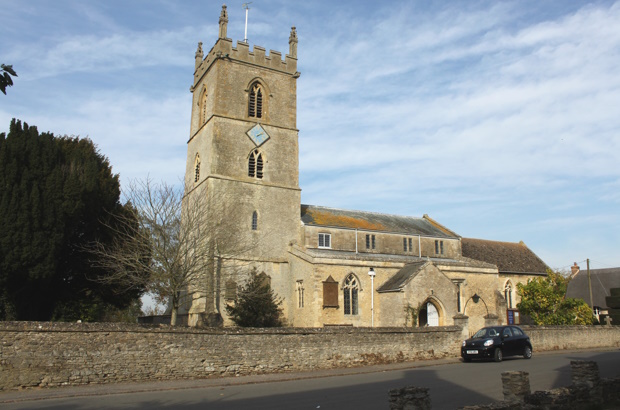


























The Church of St. Mary the Virgin, Charlton-on-Otmoor
The church of St. Mary the Virgin in Charlton-on-Otmoor dates mainly from the 13th and 14th centuries and comprises a chancel, clerestoried nave, north and south aisles, western tower, and south porch. The 13th-century nave is separated from the aisles by arcades of three arches. The northern arcade has remains of contemporary painted decoration on both arches and pillars. The three windows with quatrefoil tracery on the north side of the clerestory are probably of the same date. The tower arch is a good example of early-13th-century work. Also of the 13th century is the lower part of the tower with a lancet window in the west wall, the south aisle with its plain doorway and porch, and the walls of the north aisle. The church was extensively altered in the 14th century. New windows were inserted in the north aisle and on the west and south sides of the south aisle. In both aisles traces of an altar and piscina are to be found. An embattled upper story with crocketed pinnacles at the angles was added to the tower. The chancel was rebuilt towards the end of the 14th century, perhaps by the rector John de Craneforde (see below). The east window has four lights and reticulated tracery; the three sedilia and piscina on the south side are 14th-century as well as the plain recess opposite, which was perhaps an Easter sepulchre. In the 15th or early 16th century a new window was inserted in the south aisle, and the two-light clerestory windows on the south side may be also 16th-century. The church has been little restored. In 1757 the roof was repaired, in 1771 a gallery was erected (since removed), and in 1807 the roof was again repaired. In 1857 the roof and north wall, then in a bad state, were restored; the flat plaster ceiling in the chancel, there in 1846, may have been removed then, and the rafters of the nave partially uncovered. New seats and flooring were also installed. The tower was repaired in 1954, and in 1955 the church was reroofed and the plaster ceiling of the nave was totally removed so as to expose the medieval roof-timbers. The chief glory of the church is the richly carved rood-loft and screen, dating probably from the beginning of the 16th century and thoroughly restored in 1889. The gallery (about 3 ft. wide) rises from slender carved pillars and is supported by intersecting ribs with elaborate tracery. The screen is surmounted by a cross, which stands some 3 feet high, and is decorated with box shrub and flowers on 1 May, the feast of the dedication of the church, and again for the harvest festival. It is an immemorial custom to carry it round the parish in a May-day procession. There are some fragments of glass in the chancel windows, including a medieval figure of the Virgin and child, and a shield to Joseph Williamson of the Queen's College in the east window. There are still some medieval tiles. During the 1955 restoration some wall-paintings were uncovered on the north and south walls of the nave. The stone font is plain and round with a pyramid shaped cover of wood. The 17th-century oak altar rails are carved in the style of Grinling Gibbons, and the pulpit of panelled oak is dated 1616. In the chancel there are stone slabs to John de Craneforde, rector (1369–?), with fleurie cross and an indecipherable inscription, to Adam Airay, to K. L. (Katherine Lamplugh), and Thomas Yates, rector (d. 1721). There are a brass with the figure of a priest in a cope to Thomas Key, rector (1467–75); monuments to Adam Airay, rector (d. 1658); Katherine (d. 1671), wife of Thomas Lamplugh, rector; Robert Benn, rector (d. 1752); and tablets to William Westcar (d. 1806); to John Knipe, rector (d. 1845), and to George Riggs, rector (d. 1855). It is recorded in 1552 that the church owned among other things one silver and one gilt chalice, and there were four great bells and a sanctus bell. The plate now (1956) includes a large gilt chalice and paten cover (1670) given by Thomas Lamplugh. The present tower has a ring of five bells, of which two are 17th-century and two 18th-century. The sanctus bell is dated 1793. Historical information about St. Mary's Church is provided by British History Online. 'Parishes: Charlton-on-Otmoor', in A History of the County of Oxford: Volume 6, ed. Mary D Lobel (London, 1959), pp. 80-92. British History Online http://www.british-history.ac.uk/vch/oxon/vol6/pp80-92 [accessed 13 January 2023]. The Church of St. Mary the Virgin is a Grade I listed building. For more information about the listing see CHURCH OF ST MARY THE VIRGIN, Charlton-on-Otmoor - 1370086 | Historic England. For more information about St. Laurence's Church see Parishes: Charlton-on-Otmoor | British History Online (british-history.ac.uk). |

